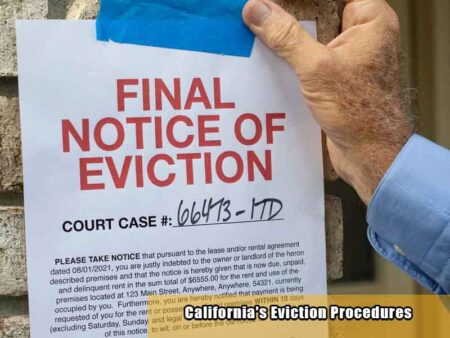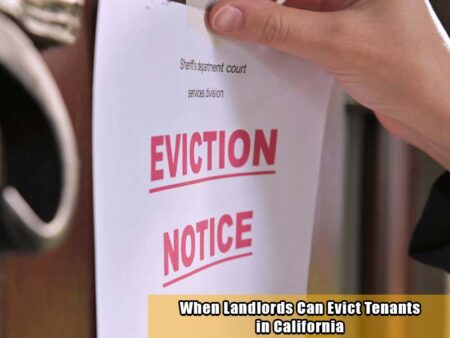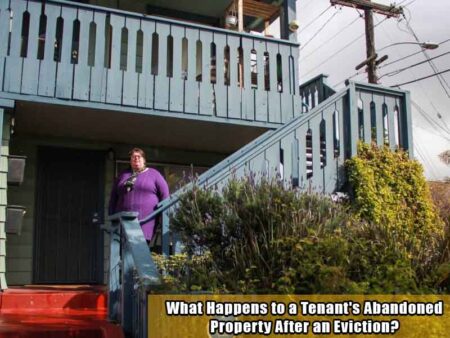Navigating the eviction process in California can be a complex and daunting task for both landlords and tenants. Understanding the legal framework and procedures involved is crucial to ensure compliance with state laws and to protect the rights of all parties involved. This blog post will provide a comprehensive guide to California’s eviction procedures, the circumstances under which landlords can evict tenants, and the steps that need to be followed.
California’s Eviction Procedures

The eviction process in California, also known as an “unlawful detainer” action, involves several key steps. These include serving the tenant with the appropriate notice, filing an eviction lawsuit if necessary, and obtaining a court order for the tenant to vacate the property. It’s essential for landlords to follow these procedures meticulously to avoid legal pitfalls.
- Notice to Vacate: The process begins with the landlord serving a written notice to the tenant. The kind of notice that is given depends on the cause of eviction.
- Filing the Unlawful Detainer Lawsuit: If the tenant does not comply with the notice, the landlord must file an unlawful detainer lawsuit in court.
- Court Proceedings: The court will schedule a hearing where both parties can present their case. A possession judgment will be issued if the landlord wins the case in court.
- Writ of Possession: The landlord can then request a writ of possession, which authorizes the sheriff to remove the tenant from the property.
- Enforcement of Eviction: The final step involves the sheriff executing the writ of possession, physically removing the tenant if they have not left voluntarily.
When Landlords Can Evict Tenants in California

Landlords in California can evict tenants for several reasons, provided they follow the state’s legal requirements. Common grounds for eviction include:
- Nonpayment of Rent: If a tenant fails to pay rent, the landlord can serve a 3-day notice to pay or quit.
- Violation of Lease Terms: Tenants who violate the terms of their lease, such as having unauthorized pets, can be given a 3-day notice to cure the violation or quit.
- Illegal Activities: Engaging in illegal activities on the property, such as drug dealing, can result in a 3-day notice to quit.
- Nuisance: Creating a nuisance or endangering the safety of other tenants or the property can also be grounds for eviction with a 3-day notice to quit.
Terminating a California Tenancy for Cause

Terminating a tenancy for cause requires the landlord to provide a specific reason for the eviction, supported by appropriate notices. The type of notice and its duration depend on the cause:
- 3-Day Notice to Pay Rent or Quit: Used when a tenant fails to pay rent.
- 3-Day Notice to Cure or Quit: Used for lease violations that can be corrected.
- 3-Day Notice to Quit: Used for serious violations like illegal activities or creating a nuisance.
If the tenant does not comply with the notice, the landlord can proceed with filing an unlawful detainer lawsuit.
Terminating a California Tenancy Without Cause

In some cases, landlords may wish to terminate a tenancy without cause. This is generally only allowed in month-to-month rental agreements and requires more extended notice periods:
- 30-Day Notice: For tenants who have lived in the rental unit for less than a year.
- 60-Day Notice: For tenants who have resided in the unit for more than a year.
It’s important to note that local rent control ordinances may impose additional restrictions on no-cause evictions.
California Eviction Laws and Process

California’s eviction laws are designed to protect both landlords and tenants. Key aspects of these laws include:
- Legal Notices: All eviction notices must be in writing and meet specific legal requirements.
- Court Proceedings: Evictions must be processed through the court system; self-help evictions are illegal.
- Tenant Defenses: Tenants have the right to present defenses in an unlawful detainer action, such as retaliatory eviction or breach of warranty of habitability.
Understanding these laws helps ensure that landlords conduct evictions legally and that tenants are aware of their rights.
What Happens When a Landlord Doesn’t Follow California Eviction Rules?
When a landlord does not follow the correct eviction process in California, several consequences can arise:
- Delay in Eviction: The court may dismiss the unlawful detainer lawsuit, delaying the eviction process.
- Tenant’s Right to Stay: The tenant may be allowed to remain in the property if the landlord’s actions are deemed unlawful.
- Legal Penalties: Landlords may face legal penalties, including fines and liability for the tenant’s damages.
Adhering to the legal procedures is crucial to avoid these issues and ensure a smooth eviction process.
What Happens to a Tenant’s Abandoned Property After an Eviction?
After an eviction, landlords often face the challenge of dealing with a tenant’s abandoned property. California law provides specific guidelines for handling such situations:
- Inventory and Storage: The landlord must take an inventory of the abandoned items and store them safely.
- Notice to Tenant: A notice must be sent to the tenant, detailing how they can reclaim their property.
- Waiting Period: The landlord must wait a specified period (usually 15 days if the notice is personally delivered, or 18 days if mailed) before disposing of the items.
- Disposal or Sale: If the tenant does not reclaim the property within the waiting period, the landlord can dispose of or sell the items. Any proceeds from the sale, after deducting storage and sale costs, must be returned to the tenant.
Resources on Evictions in California
Several resources are available to help both landlords and tenants navigate the eviction process in California:
- California Department of Consumer Affairs: Offers guidelines and publications on landlord-tenant laws.
- Legal Aid Organizations: Provide free legal services to low-income tenants facing eviction.
- Online Legal Resources: Websites like Nolo and California Courts offer detailed information and forms related to evictions.
These resources can provide valuable assistance and ensure that both parties understand their rights and obligations.
Talk to a Landlord-Tenant Attorney
Given the complexity of the eviction process in California, consulting with a landlord-tenant attorney can be highly beneficial. An experienced attorney can:
- Provide Legal Advice: Help landlords and tenants understand their rights and responsibilities.
- Prepare Legal Documents: Ensure that all notices and court filings comply with state laws.
- Represent in Court: Advocate on behalf of landlords or tenants during eviction proceedings.
Legal representation can help avoid costly mistakes and ensure a fair outcome.
Conclusion
Understanding the eviction process in California is essential for both landlords and tenants. By following the state’s legal procedures, landlords can evict tenants lawfully and avoid legal complications. Tenants, on the other hand, should be aware of their rights and defenses in an eviction action. Utilizing available resources and consulting with a landlord-tenant attorney can provide the necessary support to navigate this challenging process effectively. Whether you are a landlord or a tenant, staying informed and prepared is the key to handling evictions properly in California.
Read more blogs from Oak Loop Properties:
- What is Property Maintenance?
- Rent Collection Apps: 10 Best Apps for Landlords in 2024
- The Eviction Process in California
- Property Marketing: The Ultimate Guide
- Strategies to Improve Tenant Retention








